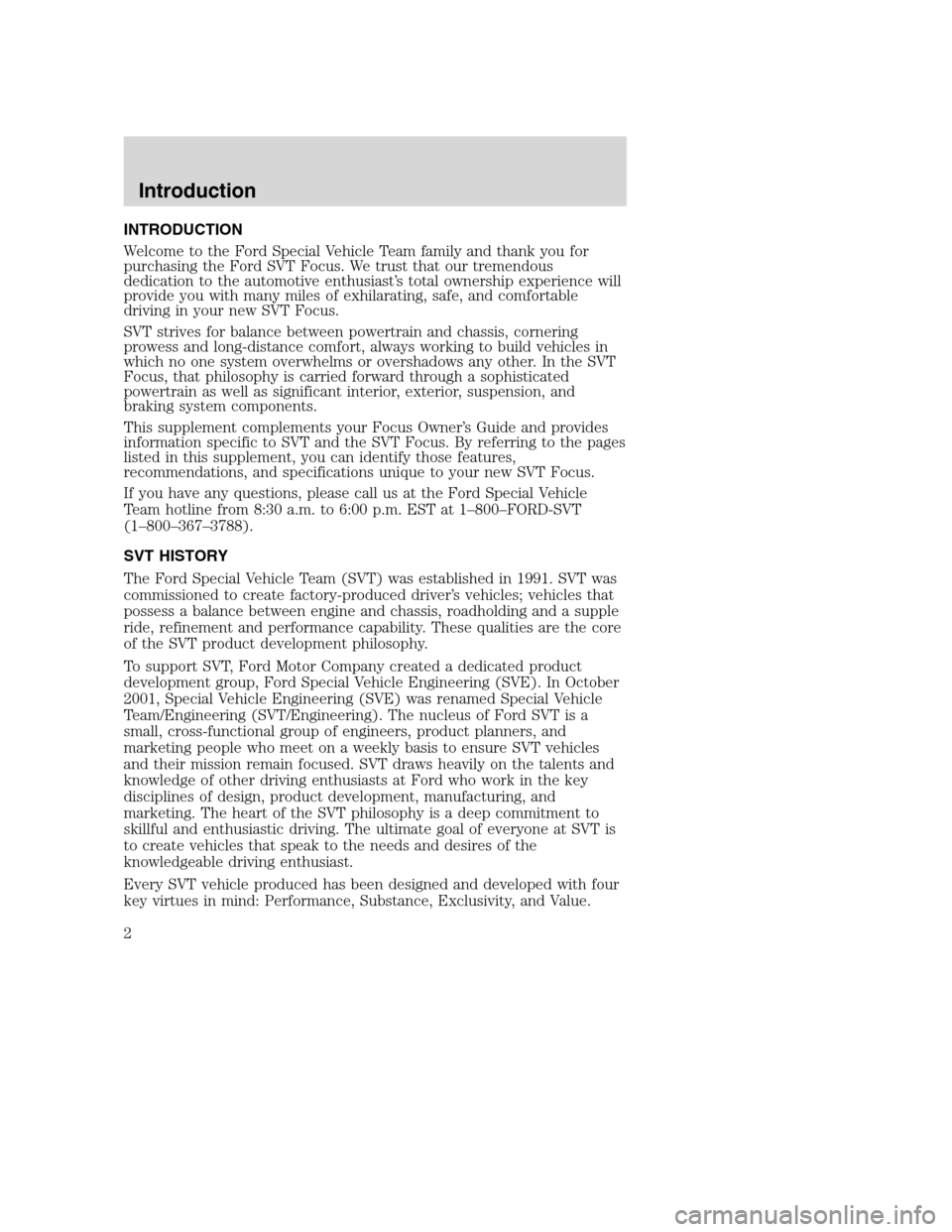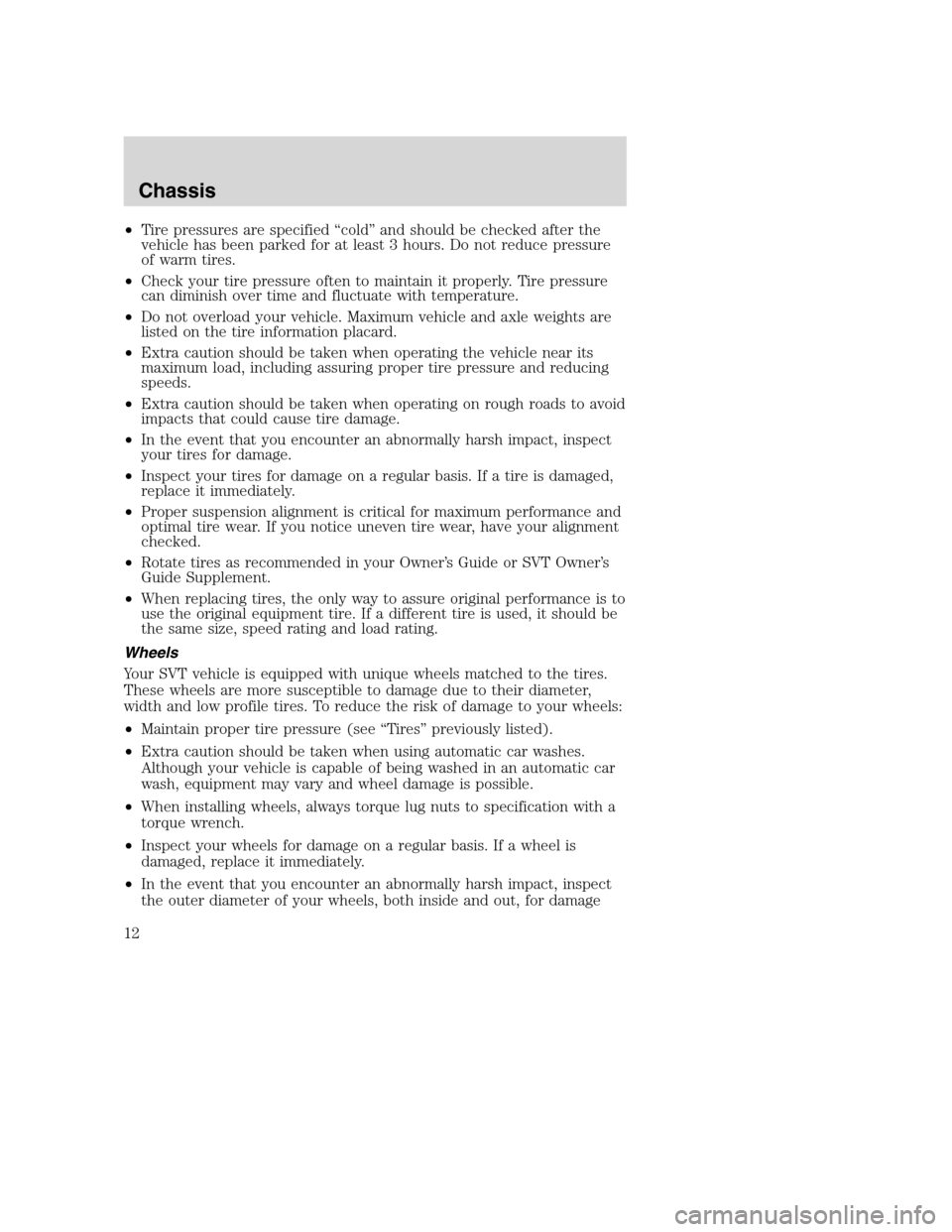Page 2 of 16

INTRODUCTION
Welcome to the Ford Special Vehicle Team family and thank you for
purchasing the Ford SVT Focus. We trust that our tremendous
dedication to the automotive enthusiast’s total ownership experience will
provide you with many miles of exhilarating, safe, and comfortable
driving in your new SVT Focus.
SVT strives for balance between powertrain and chassis, cornering
prowess and long-distance comfort, always working to build vehicles in
which no one system overwhelms or overshadows any other. In the SVT
Focus, that philosophy is carried forward through a sophisticated
powertrain as well as significant interior, exterior, suspension, and
braking system components.
This supplement complements your Focus Owner’s Guide and provides
information specific to SVT and the SVT Focus. By referring to the pages
listed in this supplement, you can identify those features,
recommendations, and specifications unique to your new SVT Focus.
If you have any questions, please call us at the Ford Special Vehicle
Team hotline from 8:30 a.m. to 6:00 p.m. EST at 1–800–FORD-SVT
(1–800–367–3788).
SVT HISTORY
The Ford Special Vehicle Team (SVT) was established in 1991. SVT was
commissioned to create factory-produced driver’s vehicles; vehicles that
possess a balance between engine and chassis, roadholding and a supple
ride, refinement and performance capability. These qualities are the core
of the SVT product development philosophy.
To support SVT, Ford Motor Company created a dedicated product
development group, Ford Special Vehicle Engineering (SVE). In October
2001, Special Vehicle Engineering (SVE) was renamed Special Vehicle
Team/Engineering (SVT/Engineering). The nucleus of Ford SVT is a
small, cross-functional group of engineers, product planners, and
marketing people who meet on a weekly basis to ensure SVT vehicles
and their mission remain focused. SVT draws heavily on the talents and
knowledge of other driving enthusiasts at Ford who work in the key
disciplines of design, product development, manufacturing, and
marketing. The heart of the SVT philosophy is a deep commitment to
skillful and enthusiastic driving. The ultimate goal of everyone at SVT is
to create vehicles that speak to the needs and desires of the
knowledgeable driving enthusiast.
Every SVT vehicle produced has been designed and developed with four
key virtues in mind: Performance, Substance, Exclusivity, and Value.
Introduction
Introduction
2
Page 11 of 16

SUSPENSION
•Front suspension: MacPherson strut, retuned struts, 22 N/mm springs,
21 mm Stabilizer Bar
•Rear suspension: multilink, retuned shocks, 27.5 N/mm springs, 21 mm
Stabilizer Bar
STEERING
TypePower assist, rack and pinion
Turns, lock to lock2.6
Turning diameter39.1
BRAKES
•The braking on the SVT Focus provides improved performance and
fade resistance to meet the demands of the driving enthusiast.
•Swept area is 18% larger on front rotors.
Front300 mm (11.8 in.) vented disc,
single-piston caliper
Rear280 mm (11.0 in.) solid disc,
single-piston caliper
ABSFour-channel, four-sensor system
TIRE INFORMATION
Important tire information
Your SVT vehicle is equipped with unique wheels and tires designed to
enhance performance and appearance. To continue providing this
performance, extra care must be taken when operating and maintaining
your vehicle.
Tires
Your SVT vehicle is equipped with low profile, high performance tires
that are designed to optimize handling, steering and braking to provide
the performance you expect in a SVT vehicle. These tires are not
optimized for off-road or winter performance, and their ride, noise and
wear characteristics are different than other tires. Also, because of their
lower profile, the tires are more susceptible to damage due to potholes
and rough or unpaved roads. To ensure that your tires perform as
designed, it is important that you maintain your tires properly:
•Always maintain your tire pressures according to the tire information
placard in the doorjamb or inside the fuel filler door, using an accurate
gauge.
Chassis
Chassis
11
Page 12 of 16

•Tire pressures are specified“cold”and should be checked after the
vehicle has been parked for at least 3 hours. Do not reduce pressure
of warm tires.
•Check your tire pressure often to maintain it properly. Tire pressure
can diminish over time and fluctuate with temperature.
•Do not overload your vehicle. Maximum vehicle and axle weights are
listed on the tire information placard.
•Extra caution should be taken when operating the vehicle near its
maximum load, including assuring proper tire pressure and reducing
speeds.
•Extra caution should be taken when operating on rough roads to avoid
impacts that could cause tire damage.
•In the event that you encounter an abnormally harsh impact, inspect
your tires for damage.
•Inspect your tires for damage on a regular basis. If a tire is damaged,
replace it immediately.
•Proper suspension alignment is critical for maximum performance and
optimal tire wear. If you notice uneven tire wear, have your alignment
checked.
•Rotate tires as recommended in your Owner’s Guide or SVT Owner’s
Guide Supplement.
•When replacing tires, the only way to assure original performance is to
use the original equipment tire. If a different tire is used, it should be
the same size, speed rating and load rating.
Wheels
Your SVT vehicle is equipped with unique wheels matched to the tires.
These wheels are more susceptible to damage due to their diameter,
width and low profile tires. To reduce the risk of damage to your wheels:
•Maintain proper tire pressure (see“Tires”previously listed).
•Extra caution should be taken when using automatic car washes.
Although your vehicle is capable of being washed in an automatic car
wash, equipment may vary and wheel damage is possible.
•When installing wheels, always torque lug nuts to specification with a
torque wrench.
•Inspect your wheels for damage on a regular basis. If a wheel is
damaged, replace it immediately.
•In the event that you encounter an abnormally harsh impact, inspect
the outer diameter of your wheels, both inside and out, for damage
Chassis
12